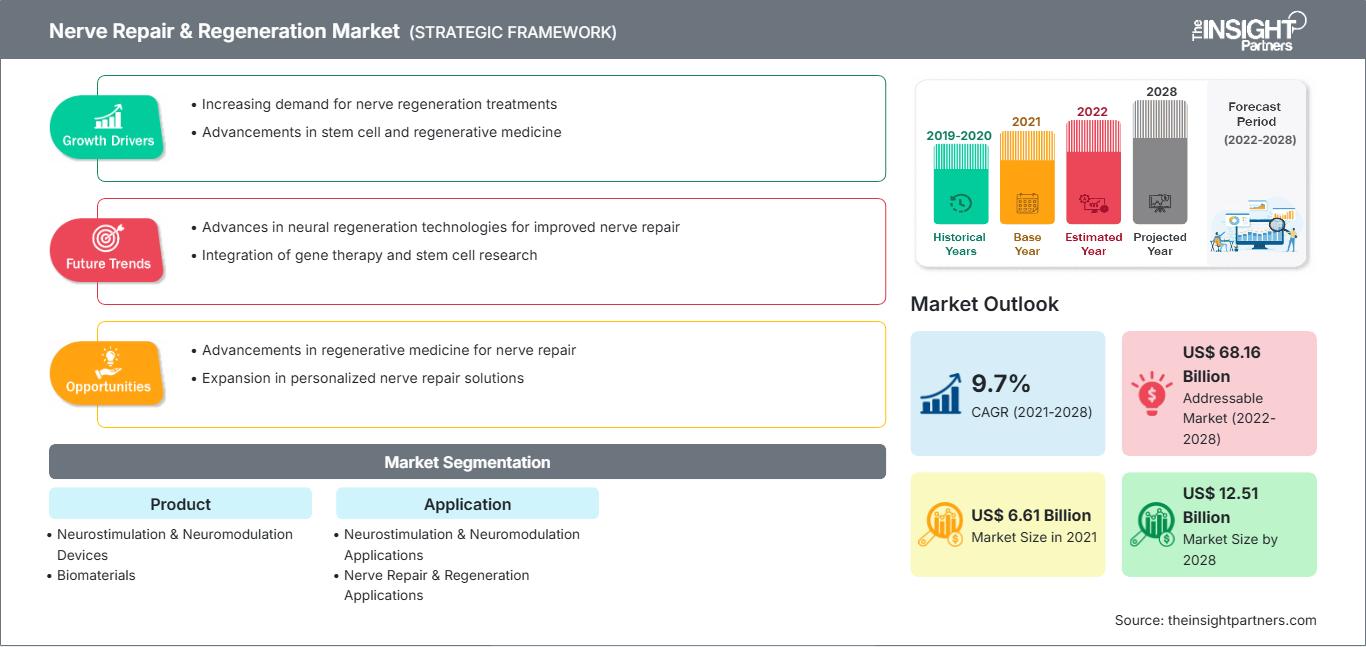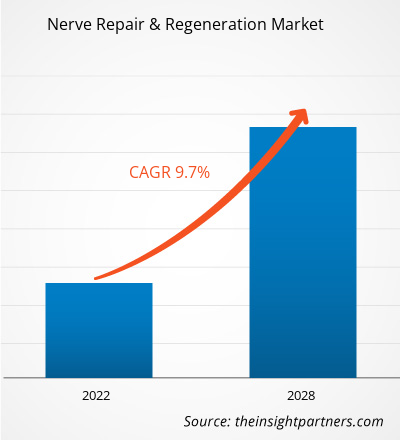神经修复与再生市场预计将从 2021 年的 66.0771 亿美元增至 2028 年的 125.1406 亿美元;预计 2022 年至 2028 年的复合年增长率为 9.7%。
神经、大脑和脊髓是神经系统的基础。神经修复是一种涉及探查受损神经并去除神经末梢受损组织或疤痕的方法。同时,神经再生是指神经组织、细胞或产物的再生长或修复。再生机制可能包括产生新的神经元、神经胶质细胞、轴突、髓鞘或突触。神经修复和再生通过各种产品进行,包括神经刺激和神经调节装置和生物材料,例如神经导管、神经包裹、神经连接器和其他生物材料。
神经修复与再生市场根据产品、应用和地域进行细分。按地域划分,神经修复与再生市场大致分为北美、欧洲、亚太地区、中东和非洲以及南美和中美洲。本报告提供了对市场的深入洞察和分析,重点关注市场趋势、技术进步、市场动态以及全球领先市场参与者的竞争格局等参数。
自定义此报告以满足您的要求
您将免费获得任何报告的定制,包括本报告的部分内容,或国家级分析、Excel 数据包,以及为初创企业和大学提供超值优惠和折扣
神经修复与再生市场: 战略洞察

-
获取本报告的主要市场趋势。这个免费样本将包括数据分析,从市场趋势到估计和预测。
市场洞察
神经损伤发病率不断上升推动神经修复与再生市场增长
神经损伤很普遍,可能对患者造成严重影响。大多数神经损伤是由慢性累积性创伤或急性损伤引起的。根据美国国家生物技术信息中心的数据,创伤性脑损伤 (TBI) 可能由各种创伤引起,从简单的头部撞击到脑部穿透性损伤。此外,根据同一来源的数据,在美国,约有 170 万人遭受创伤性脑损伤,其中青少年为 15 至 19 岁,成年人为 65 至2019年,老年人是遭受创伤性脑损伤风险最高的人群之一。
帕金森病、痴呆症、癫痫和癫痫发作、自闭症、脑肿瘤、脑瘫、阿尔茨海默病等神经系统疾病会影响人体的大脑和神经。在美国,神经系统疾病的患病率正在上升。根据美国疾病控制与预防中心 (CDC) 的数据,阿尔茨海默病是美国十大死亡原因之一。2020年,美国有580万人患有阿尔茨海默病。同样,根据帕金森基金会患病率项目的数据,估计到 2020 年美国将有 930,000 名帕金森病患者。
痴呆症目前是所有疾病中第七大致死原因,也是全球老年人致残和成瘾的主要原因之一。据世界卫生组织称,全球有超过 5500 万人患有痴呆症,每年新增近 1000 万例。痴呆症是由主要或次要影响大脑的各种疾病和损伤引起的。阿尔茨海默病是最常见的痴呆症形式,可能导致 60% 至 70% 的病例。因此,神经损伤发病率的不断上升和神经系统疾病的高患病率预计将推动神经修复和治疗的发展。预测期内,再生市场将迎来巨大增长。
老年人口增长对市场增长贡献巨大
一些神经系统疾病,如神经病、阿尔茨海默病、帕金森病和中风,在老年人中更为常见,而且随着预期寿命的延长,这些疾病的患病率也会上升。据世界卫生组织称,全球人口正在迅速老龄化。2015 年至 2050 年间,全球 60 岁以上人口将增长近一倍,从 12% 增至 22%,老年人的精神和神经系统疾病可能占该年龄组总伤残调整生命年 (DALY) 的 6.6%。此外,根据同一来源,约有 15% 的 60 岁及以上成年人患有精神疾病。
根据美国疾病控制与预防中心 (CDC) 的数据,阿尔茨海默病是 65 岁及以上人群第五大死亡原因。此外,阿尔茨海默病患者数量每五年翻一番。此外,2020 年,阿尔茨海默病影响了约 580 万 65 岁及以上的美国人,到 2060 年,这一数字预计将增长近两倍,达到 1400 万人。
神经系统疾病导致的死亡率也在上升。例如,根据阿尔茨海默病协会的数据,三分之一的老年人死于阿尔茨海默病或痴呆症。
因此,与年龄相关的神经系统疾病患病率的上升增加了对神经修复和再生治疗的需求。这一因素正在推动神经修复和再生市场的增长。
产品洞察
根据产品,全球神经修复和再生市场细分为神经刺激和神经调节设备以及生物材料。 2021 年,神经刺激和神经调节设备占据了最大的市场份额。然而,预计生物材料市场在 2022 年至 2028 年期间的复合年增长率最高。用于再生中枢神经系统 (CNS) 和周围神经系统 (PNS) 的生物材料已经得到了很好的开发。这些材料在 PNS 修复中被广泛用作神经修复膜和神经导管。生物材料促进组织修复,并充当细胞和药物治疗载体。根据美国国家医学图书馆 2020 年的数据,约 87% 的 PNS 是由创伤引起的。根据伯明翰大学的数据,全球每年报告约 130,000 例脊髓损伤新病例。所有这些因素预计都将推动生物材料领域的发展。生物材料分为神经导管、神经包裹、神经连接器和其他生物材料。
应用洞察
根据应用,神经修复与再生市场细分为神经刺激与神经调节应用以及神经修复与再生应用。神经修复与再生细分市场又细分为直接神经修复/神经缝合、神经移植和干细胞疗法。神经修复与再生细分市场在 2021 年占据了最大的市场份额。然而,由于神经技术的快速发展以及针对各种神经系统疾病的新兴有前景的疗法,预计到 2028 年,神经刺激与神经调节应用将成为市场的最大股东。
产品发布和并购是全球神经修复与再生市场参与者广泛采用的策略。近期的部分关键产品开发如下:
- 2022年2月,史赛克宣布完成对数字护理协调和沟通领域的领导者Vocera Communications, Inc.的收购。Vocera为史赛克的医疗部门带来了高度互补且创新的产品组合,这将增强公司先进的数字医疗服务,并进一步提升史赛克在整个护理过程中预防不良事件的专注度。
- 2020年1月,美敦力公司宣布收购总部位于伊利诺伊州布卢明顿的私营公司Stimgenics, LLC,该公司率先开发了一种名为差异靶区多路复用 (DTM) 脊髓刺激的新型脊髓刺激 (SCS) 波形。该疗法通过美敦力Intellis平台提供,是一种治疗慢性疼痛患者的全新独特编程选项。
神经修复与再生市场区域洞察
The Insight Partners 的分析师已详尽阐述了预测期内影响神经修复与再生市场的区域趋势和因素。本节还讨论了北美、欧洲、亚太地区、中东和非洲以及南美和中美洲的神经修复与再生市场细分和地域分布。
神经修复与再生市场报告范围
| 报告属性 | 细节 |
|---|---|
| 市场规模 2021 | US$ 6.61 Billion |
| 市场规模 2028 | US$ 12.51 Billion |
| 全球复合年增长率 (2021 - 2028) | 9.7% |
| 历史数据 | 2019-2020 |
| 预测期 | 2022-2028 |
| 涵盖的领域 |
By 产品
|
| 覆盖地区和国家 |
北美
|
| 市场领导者和主要公司简介 |
|
神经修复与再生市场参与者密度:了解其对业务动态的影响
神经修复与再生市场正在快速增长,这得益于终端用户需求的不断增长,而这些需求的驱动因素包括消费者偏好的演变、技术进步以及对产品优势的认知度的提升。随着需求的增长,企业正在扩展产品线,不断创新以满足消费者需求,并抓住新兴趋势,从而进一步推动市场增长。

- 获取 神经修复与再生市场 主要参与者概述
新冠疫情对神经修复与再生市场的影响好坏参半。2020 年第一季度,封锁限制限制了神经损伤病例,导致神经修复外科手术对生物材料的需求减少。车祸是造成周围神经损伤的最常见原因,但在封锁期间,由于活动受限,神经损伤有所减少。然而,美国卫生与公众服务部报告称,2020 年解除封锁后,美国因事故或意外伤害死亡的人数增加了近 17%。报告还称,事故是 2020 年第四大死亡原因,死亡人数仅比新冠死亡人数少 15 万。这些死亡是由于新冠安全规程导致意外病例外科手术延误造成的。此外,在 2020 年第一季度之后,由于神经损伤治疗和外科手术的增加,市场以平均速度增长。
根据地域划分,全球神经修复和再生市场主要分为北美、欧洲、亚太地区、中东和非洲 (MEA) 以及南美洲和中美洲。北美市场进一步细分为美国、加拿大和墨西哥。欧洲市场细分为法国、德国、英国、西班牙、意大利和欧洲其他地区。亚太地区市场细分为日本、中国、印度、澳大利亚、韩国和亚太地区其他地区。MEA 的神经修复和再生市场进一步细分为沙特阿拉伯、阿联酋、南非和 MEA 其他地区。南美洲和中美洲市场细分为巴西、阿根廷和南美洲和中美洲其他地区。
全球神经修复和再生市场中很少有公司再生市场的主要参与者是 Axogen Corporation、Boston Scientific Corporation、Integra LifeSciences、Medtronic、Abbott Laboratories、Stryker Corporation、Neuronetics、LivaNova PLC、Baxter 和 Polyganics BV。
- 历史分析(2 年)、基准年、预测(7 年)及复合年增长率
- PEST和SWOT分析
- 市场规模、价值/数量 - 全球、区域、国家
- 行业和竞争格局
- Excel 数据集
近期报告
客户评价
购买理由
- 明智的决策
- 了解市场动态
- 竞争分析
- 客户洞察
- 市场预测
- 风险规避
- 战略规划
- 投资论证
- 识别新兴市场
- 优化营销策略
- 提升运营效率
- 顺应监管趋势






















 获取免费样品 - 神经修复与再生市场
获取免费样品 - 神经修复与再生市场